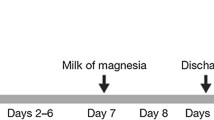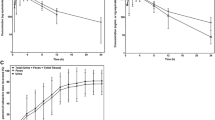Abstract
Purpose
This study aimed to characterize the primary routes of elimination of the pan-HER tyrosine kinase inhibitor, dacomitinib (PF-00299804), to evaluate the pharmacokinetics of total radioactivity and of dacomitinib and to identify the metabolites of dacomitinib in plasma, urine, and feces in the healthy volunteers.
Methods
Six male healthy volunteers (mean age 31.5 years) received a single 45-mg oral dose containing ~100 μCi [14C] dacomitinib. Whole blood, urine, and fecal samples were collected throughout the study and analyzed for total radioactivity by liquid scintillation counting. Safety evaluations included vital signs, 12-lead ECGs, safety laboratory tests, and monitoring of adverse events.
Results
78.8 % of the radiolabeled material was excreted in feces, and 3.2 % was recovered in urine. Peak concentrations of dacomitinib in plasma occurred 12 h (median) after oral dosing. Mean terminal plasma half-life was 55 and 182 h for dacomitinib and total plasma radioactivity, respectively. Geometric mean C max was approximately 2-fold higher, and total exposure (AUCinf) was almost 6-fold higher for total radioactivity than for dacomitinib in plasma. O-desmethyl dacomitinib (PF-05199265) was the major circulating metabolite. T max of this metabolite occurred 6 h after oral dosing with dacomitinib. Plasma exposure for the metabolite was one-third that of the parent compound. There were no serious/severe adverse events or deaths during the study. Dacomitinib was well tolerated.
Conclusions
In humans, [14C] dacomitinib underwent oxidative and conjugative metabolism. Most of the administered dose was eliminated via the fecal route, and the major circulating metabolite was PF-05199265.


Similar content being viewed by others
References
Engelman JA, Zejnullahu K, Gale C-M et al (2007) PF00299804, an irreversible pan-ERBB inhibitor, is effective in lung cancer models with EGFR and ERBB2 mutations that are resistant to gefitinib. Cancer Res 67:11924–11932
Gonzales AJ, Hook KE, Althaus IW et al (2008) Antitumor activity and pharmacokinetic properties of dacomitinib, a second-generation irreversible pan-erbB receptor tyrosine kinase inhibitor. Mol Cancer Ther 7:1880–1889
Pfizer Inc. Data on file
Jänne PA, Schellens JH, Engelman JA et al (2008) Preliminary activity and safety results from a phase I clinical trial of dacomitinib, an irreversible pan-HER inhibitor, in patients with NSCLC. J Clin Oncol 26(15S) (abstr. 8027)
Jänne PA, Reckamp KL, Koczywas M et al (2009) Efficacy and safety of dacomitinib in patients with advanced NSCLC after failure of at least one prior chemotherapy regimen and prior treatment with erlotinib: a two-arm, phase II trial. J Clin Oncol 27(15S) (abstr. 8063)
Jänne PA, Boss DS, Camidge DR et al (2011) Phase I dose-escalation study of the pan-HER inhibitor, PF299804, in patients with advanced malignant solid tumors. Clin Cancer Res 17:1131–1139
Boyer MJ, Blackhall FH, Park K et al (2010) Efficacy and safety of PF299804 versus erlotinib: a global, randomized phase II trial in patients with advanced non-small cell lung cancer after failure of chemotherapy. J Clin Oncol 28(18S) (abstr. LBA7523)
Mok T, Spigel DR, Park K et al (2010) Efficacy and safety of dacomitinib, an oral, irreversible, pan-human epidermal growth factor receptor tyrosine kinase inhibitor, as first-line treatment of selected patients with advanced non-small cell lung cancer. J Clin Oncol 28(15S) (abstr. 7537)
Park K, Heo DS, Cho B et al (2010) Dacomitinib in Asian patients with non-small cell lung cancer refractory to chemotherapy and erlotinib or gefitinib: a phase I/II study. J Clin Oncol 28(15S) (abstr. 7599)
Ramalingam SS, Boyer MJ, Park K et al (2010) Randomized phase 2 study of dacomitinib, an irreversible human epidermal growth factor inhibitor, versus erlotinib in patients with advanced non-small cell lung cancer after chemotherapy failure: quantitative and qualitative benefits. Ann Oncol 21(Suppl 8):viii122–viii123
Bello CL, LaBadie RR, Ni G et al (2012) The effect of dacomitinib (PF-00299804) on CYP2D6 activity in healthy volunteers who are extensive or intermediate metabolizers. Cancer Chemother Pharmacol 69:991–997
Hamilton RA, Garnett WR, Kline BJ (1981) Determination of a mean valproic acid serum level by assay of a single pooled sample. Clin Pharmacol Ther 29:408–413
Scheffler M, Di Gion P, Doroshyenko O et al (2011) Clinical pharmacokinetics of tyrosine kinase inhibitors. Focus on 4-anilinoquinazolines. Clin Pharmacokinet 50:371–403
Joshi SS, Ortiz S, Witherspoon JN et al (2010) Effects of epidermal growth factor receptor inhibitor-induced dermatologic toxicities on quality of life. Cancer 116:3916–3923
Lynch TJ Jr, Kim ES, Eaby B et al (2007) Epidermal growth factor receptor inhibitor-associated cutaneous toxicities: an evolving paradigm in clinical management. Oncologist 12:610–621
Segaert S, Van Cutsem E (2007) Clinical management of EGFRI dermatologic toxicities: the European perspective. Oncology (Williston Park) 21(11 Suppl. 5):22–26
Acknowledgments
The authors would like to thank Klaas Schildknegt, Carol McCormick, and Tanya Boutros, Pfizer Inc., for their valuable contributions to this study. This study was sponsored by Pfizer Inc. Medical writing support was provided by Rachel Mason at ACUMED® (Tytherington, UK) with funding from Pfizer Inc.
Conflict of interest
Carlo L. Bello, Evan Smith, Ana Ruiz-Garcia, Grace Ni, Christine Alvey, and Cho-Ming Loi were all employees of Pfizer Inc. when conducting this research.
Author information
Authors and Affiliations
Corresponding author
Rights and permissions
About this article
Cite this article
Bello, C.L., Smith, E., Ruiz-Garcia, A. et al. A phase I, open-label, mass balance study of [14C] dacomitinib (PF-00299804) in healthy male volunteers. Cancer Chemother Pharmacol 72, 379–385 (2013). https://doi.org/10.1007/s00280-013-2207-9
Received:
Accepted:
Published:
Issue Date:
DOI: https://doi.org/10.1007/s00280-013-2207-9




